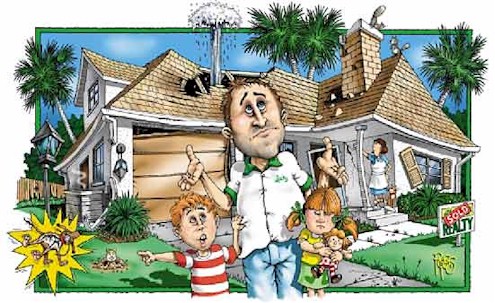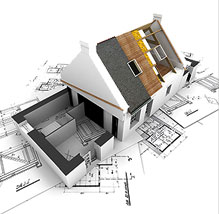Our sample "Walk Through" Home Inspection gives you a feel for the inspection we will do for you.
Topic: Home Inspections

Are you ready? Let’s start by strongly encouraging you to participate in the home inspection. If it is at all possible, try to be present for the inspection. The inspection report you receive is very detailed and easy to understand, (every room is individually reported) but it is always easier to understand when you have participated in the inspection yourself.
During the inspection you will be encouraged to ask questions about the house and voice your concerns, no matter how trivial they may seem. This is your opportunity to learn about the house, its systems and controls, as well as home safety and maintenance needed.
Every inspection is different and takes into account your particular situation whether you're "handy" around the home or whether you're looking for a "low maintenance" house. Our inspector will also consider your family and any special safety issues you have that relate to children or the elderly.
Now.... we get serious
Let's Begin the Inspection.
Our inspections begin with the inspector explaining to you about the inspection and how it will progress through the house, and you will receive a brief overview of what the inspection entails.
The Grounds are of great concern. The grading, walkways, driveway, patio and deck are all inspected. Downspout positions, condition and drainage patterns are observed. Outside hose bibs and electrical outlets are all checked. The electrical service wire is observed and any dangerous conditions noted along with the condition of the fascia and soffit.
Grading and vegetation along side the house is described. Hose bibs, lighting, outlets and main electrical supply type are all described in detail. Types of driveway, patio, porch, walkways, decks, and retaining walls included.
The Roof, gutters and chimney are observed. The roof is examined from the ground looking for signs of deterioration, damage, wear, or failure. In some cases the inspector will observe the roof from a ladder at the eaves during the inspection, in other instances binoculars are used to observe the roof, or a combination of both.
The report reflects how the roof is inspected, the material, type of roof, as well as approximate age. Types of flashing, valleys and skylights. Chimney locations, type of flue, cap / crown and flashing as well as the plumbing vents, gutter, downspout and leaders are all identified.
As the Inspector Continues around the exterior of the house.
The Exterior of the house is given a thorough going over. In this phase, particular attention is paid to the exterior facades and the foundation area. The inspector looks for cracks, sagging, bowing or deflection that are possible signs of serious structural failure.
The exterior of all windows and doors are examined and the condition of all the trim work and caulking is observed.
The type of exterior finish and trim types are described. Soffit and fascia types (trims) are noted. The front door and patio door types described. The types of windows, storms and screens are noted.
Then, it's on to the Garage where the floor, walls, ceiling, outlets, lighting, and windows are all checked. The garage door seals and weather stripping are examined. The door opener is operated and the safety devices checked.
Location, type of structure and number of car spaces are noted. Garage door type and operation, as well as door opener information are recorded. Roof, gutters, downspouts, leaders, structure, service door, walls, floor, ceiling and window information noted. Descriptions of hose bibs, lighting, outlets and heating are entered in the report.
The outside is complete!
 And it's time to go inside.... are you still following?
And it's time to go inside.... are you still following?
Attic area
This is then entered and examined in its entirety. The access ladder is checked for safe operation. If there is a whole house fan it is operated. Attic fans are operated and their cut in temperature checked. All roof, soffit and cross vents are examined. The roofs decking is inspected for signs of rotting, leaks or serious structural failure. The trusses and rafters are inspected for signs of damage. All lighting, wiring and junction boxes are inspected. Bathroom vent fans discharge pipes observed. The chimney, plumbing vent pipes and insulation are examined.
Roof framing and sheeting types are identified. Ventilation and insulation type and depth recorded. Attic and house fans described, bathroom venting, lighting and outlets noted.
Every Room in the house is inspected; all the windows are opened and closed, the glazing and locks are checked. All accessible electrical outlets are tested for correct polarity and proper grounding if applicable. All lights are operated, air vents and returns checked. The floors, walls, and ceilings are examined. Doors are operated, and closets inspected. If you intend using a computer in a particular room we can test those outlets for computer compatible grounding.
The report will describe the wall and floor coverings as well as ceiling type. If there is a closet and type. The door and window types, if the room has outlets and lighting circuits or just outlets, and the type of HVAC supply.
All Bathrooms are examined with particular attention paid to water leaks, the operation and attachment of the toilet and tank, sink or vanity units, bathtub, Jacuzzi tub, shower tray, faucets, and water flow. Tiling, grouting, caulking, ventilation fans as well as lighting and electrical outlets are all examined.
The ceiling , floor, walls, doors and windows are fully described, along with the counter top and cabinet type. Sinks, toilet, bath tub and shower are described, as well as ventilation, HVAC and electrical outlets and lighting.
In the Laundry Room the washing machine hook up is examined. The clothes dryer connections and vent pipe inspected. The dryer vent pipe length and termination is checked. The laundry sink, faucets and drain are inspected.
Washing machine and dryer hook-ups are all described in detail. If gas for the dryer is available and the type of dryer outlet (three of four prong) is noted. Laundry sink and drain type is described. The walls, ceiling, floors, doors and windows are described. Electrical and HVAC types noted.
As each room is inspected the inspector will discuss various aspects of the room with you, pointing out positive features as well as any problem, or potential problem areas. During the inspection you will be learning useful maintenance tips and helpful suggestions for doing home improvements.
Fireplace / Stove, hearth, damper, smoke chamber and chimney are inspected with particular attention being paid to safety.
Location, construction, fuel, flue and damper type all noted. Hearth and insert are described.
The Kitchen, starting with the stove, dishwasher, garbage disposal, cabinets, countertop, plumbing, all the accessible outlets, light fixtures, air vents and returns, windows, walls, floors, ceiling, and doors. All are checked and operated.
The report will include the brand names, equipment types and descriptions of the appliances. Descriptions of the cabinets, countertops, sink, faucet type as well as floor and wall coverings. Ceiling finish, electrical outlets and / or lighting, window types and HVAC source are all noted.
The Heating System is inspected and operated. The furnace along with the blower, burners, flue pipe, draft control, chimney, fuel lines, electrical connections, shut off switches, and air filter are all examined.
The location of the system, brand name, capacity (BTU's) and fuel type along with approximate age and a description of the area served is noted. Distribution, flue pipe type, thermostat type and additional devices are noted.
The air-conditioning unit is inspected, the temperature difference between the flow and return vents is monitored. The compressor, condenser, evaporator coil and fan are all examined. Refrigerant lines, piping insulation, condensate drain checked, and condensate pump operated if applicable.
Manufacturer, type of cooling, location, area served, fuel, and temp differential (delta-T), refrigerant lines, along with the type of electrical disconnect, condensate removal, thermostat, and condition of the coil and condenser are noted.
Plumbing Components, all the water, drain and vent pipes are inspected for damage, leaks, or deterioration.
The report describes in detail the types of piping used for the water main, interior water lines, drain and vent pipes. Location of the main water shutoff is noted. Water softener operation recorded.
As the inspection proceeds the inspector will keep you up-to-date showing you what he sees and answering any questions you have.
The Water Heater's condition and operation is checked, burner examined, and the flue pipes condition and installation are noted. Gas lines or electrical connections are examined. Water temperature (approx) and pressure relief valve are checked as well as the plumbing connections and shut off valves.
It's location, operation, manufacturer, fuel type, approximate age, capacity and area served are noted in the report, along with the type of flue pipe and info on the TPR valve and pipe.
The Load Center ( breaker panel or fuse box) is opened, the cover removed and the wiring examined. The wiring is checked for hazardous conditions (over fusing, double taps, scorching etc)
For your information the incoming service size, amperage, and wire type, along with info on GFCI's, grounding, and smoke detectors is noted. The electric panel - it's location, manufacturer, maximum capacity, size of main over current protector, description of breakers or fuses, and bonding. All sub panels are fully described.
Basement
Particular attention being paid to the foundation walls and floor. Signs of cracking, bulging, bowing, damp, mildew, rot or other serious problems are investigated, discussed with you and noted. The sump pump is operated, water level monitored and the non-return valve checked.
The first floor joists, sill plate and band board are examined as well as all the wiring, plumbing, heating and cooling components in the ceiling.
Ceiling, floor, walls, doors, windows, stairs and electrical components are all described. Floor drains, sump pumps, insulation and ventilation noted in detail.
Crawl Space is entered and is inspected from end to end. This area is examined with particular attention being paid to ventilation, insulation, drainage, foundation, wiring, plumbing and health issues.
Access entrance is noted. Ceiling, floor, walls, electrical components, sump pump, insulation, ventilation and HVAC are all described in detail.
All Smoke, Fire, and Carbon Monoxide alarms are tested as the inspector goes through the house. Ways of making your future home a safer place to live in are discussed.
The report describes the type of alarms in the house.
Any Pest or mold infestation problem observed by the inspector will be brought to your attention and recommendations made. This is not a substitute for a termite or mold inspection.
The location of any problem observed is given in the report.
At the conclusion of the inspection inspector will go over the complete report with you and walk you through the house again (if you need to) discussing any concerns you may have and answering any other questions you might still have.
Finally, you receive your inspection report within 2 business days. Bound in a soft cover folder is the certified inspection report with overall evaluation and summary report. The report will also include any known recalls on any system utilized in the structure. Also included are the Wisconsin Administrative Code and the WISPECT® Standards of Practice and Code of Conduct (explaining the protocol the inspector used to base the observations on), along with a home maintenance schedule and information on safety in your "new" home.
If you have any questions that this walk through did not answer please call us with your questions or concerns at (715) 393-5442.
Note: If the inspection is a pre-listing inspection (for a home seller or real estate agency) or for a homeowner as a general maintenance inspection, additional punch list items are added to the report. This lists all the decorative or trim items that need to be repaired or replaced, these items are not included in a regular home inspection.
Posted by wispectllc
at 9:57 AM EST
Updated: Wednesday, January 23, 2013 10:15 AM EST


 WISCONSIN DEPARTMENT OF SAFETY & PROFESSIONAL SERVICES
WISCONSIN DEPARTMENT OF SAFETY & PROFESSIONAL SERVICES 

 WISPECT LLC® offers one- and two-family residential design services to individuals and companies wanting to add to, build, expand, or remodel a home in Wisconsin. We’ll take your dream and make it a reality. A residential designer with WISPECT® will conduct an in-house interview to ascertain the details you want incorporated into your new home. When we have completed designing your new home the plans will be ready for submission for a Wisconsin Uniform Building Permit or other type of municipal permit.
WISPECT LLC® offers one- and two-family residential design services to individuals and companies wanting to add to, build, expand, or remodel a home in Wisconsin. We’ll take your dream and make it a reality. A residential designer with WISPECT® will conduct an in-house interview to ascertain the details you want incorporated into your new home. When we have completed designing your new home the plans will be ready for submission for a Wisconsin Uniform Building Permit or other type of municipal permit.